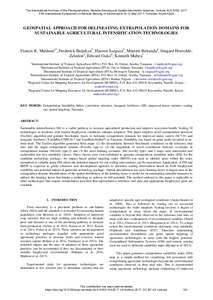| dc.contributor.author | Muthoni, Francis K. |
| dc.contributor.author | Baijukya, Frederick P. |
| dc.contributor.author | Sseguya, H. |
| dc.contributor.author | Bekunda, Mateete A. |
| dc.contributor.author | Hoeschle-Zeledon, Irmgard |
| dc.contributor.author | Ouko, E. |
| dc.contributor.author | Mubea, K. |
| dc.date.accessioned | 2019-12-04T11:11:21Z |
| dc.date.available | 2019-12-04T11:11:21Z |
| dc.date.issued | 2017-11-16 |
| dc.identifier.citation | Muthoni, F.K., Baijukya, F., Sseguya, H., Bekunda, M., Hoeschle-Zeledon, I., Ouko, E. and Mubea, K. 2017. Geospatial approach for delineating extrapolation domains for sustainable agricultural intensification technologies. The International Archives of the Photogrammetry, Remote Sensing and Spatial Information Sciences XLII-3/W2:145-149. |
| dc.identifier.issn | 2194-9034 |
| dc.identifier.uri | https://hdl.handle.net/20.500.12478/2411 |
| dc.description.abstract | Sustainable intensification (SI) is a viable pathway to increase agricultural production and improve ecosystem health. Scaling SI technologies in locations with similar biophysical conditions enhance adoption. This paper employs novel extrapolation detection (ExeDet) algorithm and gridded bioclimatic layers to delineate extrapolation domains for improved maize variety (SC719) and inorganic fertilizers (YaraMila-CEREAL® and YaraBela-Sulfan®) in Tanzania. Suitability was based on grain yields recorded in on-farm trials. The ExeDet algorithm generated three maps: (1) the dissimilarity between bioclimatic conditions in the reference trial sites and the target extrapolation domain (Novelty type-1), (2) the magnitude of novel correlations between covariates in extrapolation domain (Novelty type-2) and (3) the most limiting covariate. The novelty type1 and 2 maps were intersected and reclassified into five suitability classes. These classes were cross-tabulated to generate extrapolation suitability index (ESI) for the candidate technology package. An impact based spatial targeting index (IBSTI) was used to identify areas within the zones earmarked as suitable using ESI where the potential impacts for out scaling interventions can be maximized. Application of ESI and IBSTI is expected to guide extension and development agencies to prioritize scaling intervention based on both biophysical suitability and potential impact of particular technology package. Annual precipitation was most limiting factor in largest area of the extrapolation domain. Identification of the spatial distribution of the limiting factor is useful for recommending remedial measures to address the limiting factor that hinder a technology to achieve its full potential. The method outlined in this paper is replicable to other technologies that require extrapolation provided that representative reference trial data and appropriate biophysical grids are available. |
| dc.description.sponsorship | United States Agency for International Development |
| dc.language.iso | en |
| dc.subject | Intensification |
| dc.subject | Farming Systems |
| dc.subject | Maize |
| dc.title | Geospatial approach for delineating extrapolation domains for sustainable agricultural intensification technologies |
| dc.type | Journal Article |
| dc.description.version | Peer Review |
| cg.contributor.crp | Maize |
| cg.contributor.affiliation | International Institute of Tropical Agriculture |
| cg.contributor.affiliation | Regional Centre for Mapping Resources for Development, Kenya |
| cg.coverage.region | Africa |
| cg.coverage.region | East Africa |
| cg.coverage.region | Southern Africa |
| cg.coverage.country | Tanzania |
| cg.creator.identifier | Irmgard Hoeschle-Zeledon: 0000-0002-2530-6554 |
| cg.authorship.types | CGIAR and developing country institute |
| cg.journal | International Archives of the Photogrammetry, Remote Sensing and Spatial Information Sciences |
| cg.howpublished | Formally Published |
| cg.accessibilitystatus | Open Access |
| local.dspaceid | 92452 |
| cg.targetaudience | Scientists |
| cg.identifier.doi | https://dx.doi.org/10.5194/isprs-archives-XLII-3-W2-145-2017 |

